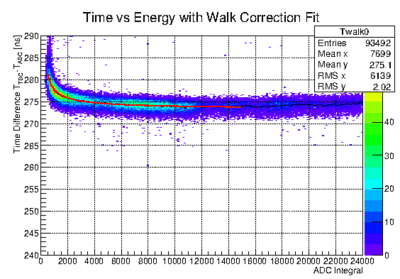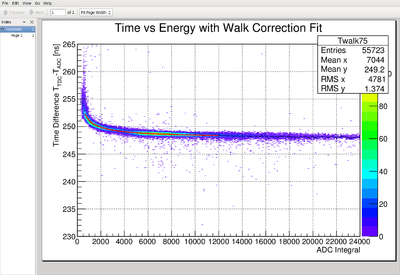Difference between revisions of "First look at TOF calibration"
From GlueXWiki
| (30 intermediate revisions by the same user not shown) | |||
| Line 5: | Line 5: | ||
*# take care of the 6fold trigger timing shift in the TDC (24ns window) | *# take care of the 6fold trigger timing shift in the TDC (24ns window) | ||
| − | * | + | * Do a rough determination of the walk correction by using the time in the ADC as reference. |
*# calculate Time difference: <math>\Delta t = t^{i}_{TDC}-t^{i}_{ADC}</math> | *# calculate Time difference: <math>\Delta t = t^{i}_{TDC}-t^{i}_{ADC}</math> | ||
*# calculate Integral: I = pulse_integral - pulse_pedestal*nsamples | *# calculate Integral: I = pulse_integral - pulse_pedestal*nsamples | ||
| − | *# [[File: | + | *# [[File:w.gif|400px|tumb||walk correction fit]] |
| + | *# Note: the minimum ionizing peak is between 6000 and 10000 | ||
| + | *# After using the correct timing conversion of 23.4375 ps/bin the following much narrower distribution is achieved | ||
| + | *# [[File:Screenshot-walk_correction_example.pdf.png|400px|tumb||walk correction and fit]] | ||
| + | |||
| + | * Do mean time comparison between different planes | ||
| + | *# calculate MeanTime of Paddle i in plane j: <math> MT^{i}_{plane j} = (t_{right} + t_{left})/2. </math> | ||
| + | *# calculate MeanTime for all Paddles n in plane k: <math> MT^{n}_{plane k} = (t_{right} + t_{left})/2. </math> | ||
| + | *# For each Reference paddle in plane j: <math> MT^{paddle_{n}}_{plane_{k}} - MT^{REF}_{plane_{j}} </math> | ||
| + | *# [[File:example_mtdiff.gif|400px]] | ||
| + | *# and after using the correct timing conversion of 23.4375ps/bin: | ||
| + | *# [[File:mantimediff_goodtiming.png|400px]] | ||
| + | *# Fit the meant time peak of each projection. This is the relative mean-time difference. | ||
| + | *# [[File:Fit_projection_example1.gif|400px]] example 1 | ||
| + | *# [[File:Fit_projection_example2.gif|400px]] example 2 | ||
| + | *# and now a good example after using the correct timing conversion | ||
| + | *# [[File:Screenshot-mtdiff_vs_padnum_proj_example42.pdf.png|400px]] | ||
| + | *# and an example where the automatic fit failed because the meantime peak is smaller than the background | ||
| + | *# [[File:Screenshot-mtdiff_vs_padnum_proj_example44.pdf.png|400px]] | ||
| + | *# Do this for each paddle in the first plane as reference paddle. | ||
| + | *# Choose one paddle in the first plane as THE REFERENCE PADDLE | ||
| + | *# Calculate the difference between the fit results of each paddle in the first plane w.r.t. THE REFERENCE PADDLE and fit the distribution | ||
| + | *# [[File:Meantime_average_to_refpaddle_example.gif|400px]] average difference of mean time to REFERENCE PADDLE | ||
| + | *# Now we have offsets for the Mean-Time for all Paddles w.r.t. THE REFERENCE PADDLE | ||
| + | |||
| + | * Do time difference comparison of one paddle with the paddle number in the other plane | ||
| + | *# calculate time difference: <math> \Delta t^{i}_{plane j} = (t_{right} - t_{left})/2. </math> | ||
| + | *# plot this time difference vs. paddle number of paddles that got hit in the other plane | ||
| + | *# [[File:PaddleNumber_vs_deltat_example.gif|400px]] | ||
| + | *# again look at each projection and fit the <math>\Delta t</math> peak | ||
| + | *# [[File:deltat_fitposition_example.gif|400px]] [[File:deltat_fitposition_p18_example.gif|400px]] example fits | ||
| + | *# now one can also plot the fit results as a function of paddle number. The inverse slope is the speed module paddle pitch | ||
| + | *# [[File:velocity_example.gif|400px]] | ||
| + | *# one can also plot the difference between symmetric paddles around the beam hole <math>\Delta t_{left} - \Delta t_{right}</math> | ||
| + | *# [[File:timediff_planesymmetry_example.gif|400px]] choose the intersection at zero for the time difference offset | ||
| + | |||
| + | * Now we have offsets for time difference (TD) and mean time (MT) | ||
| + | *# offset for the left pmt: <math> c_{left} = (MT-TD)/2. </math> | ||
| + | *# offset for the right pmt: <math> c_{right} = (MT+TD)/2. </math> | ||
| + | *# as a bonus we get the effective speed of light for each paddle. | ||
Latest revision as of 13:32, 17 April 2015
First Look
- first select data sample with the following conditions:
- only consider hits within 50ns of the timing peak both for ADC data and TDC data
- only consider paddles that have hits on both ends
- take care of the 6fold trigger timing shift in the TDC (24ns window)
- Do a rough determination of the walk correction by using the time in the ADC as reference.
- Do mean time comparison between different planes
- calculate MeanTime of Paddle i in plane j:

- calculate MeanTime for all Paddles n in plane k:

- For each Reference paddle in plane j:

-
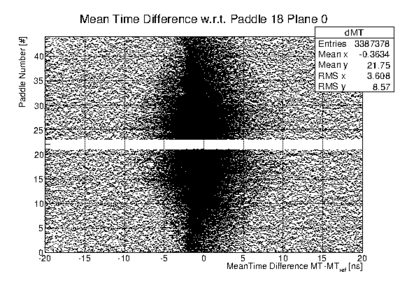
- and after using the correct timing conversion of 23.4375ps/bin:
-
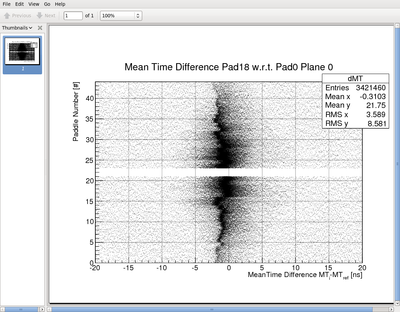
- Fit the meant time peak of each projection. This is the relative mean-time difference.
-
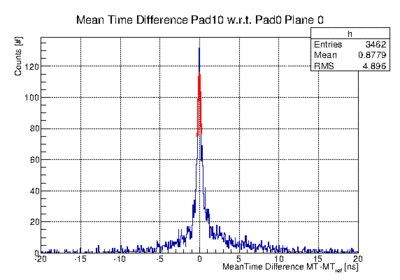 example 1
example 1 -
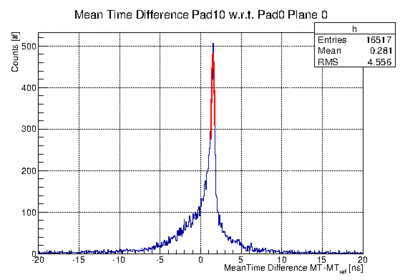 example 2
example 2 - and now a good example after using the correct timing conversion
-
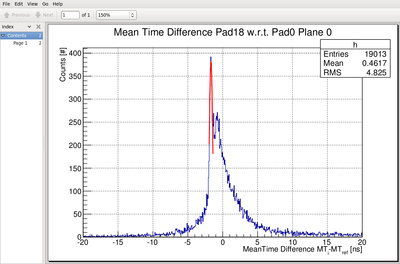
- and an example where the automatic fit failed because the meantime peak is smaller than the background
-
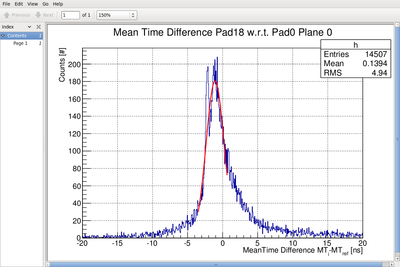
- Do this for each paddle in the first plane as reference paddle.
- Choose one paddle in the first plane as THE REFERENCE PADDLE
- Calculate the difference between the fit results of each paddle in the first plane w.r.t. THE REFERENCE PADDLE and fit the distribution
-
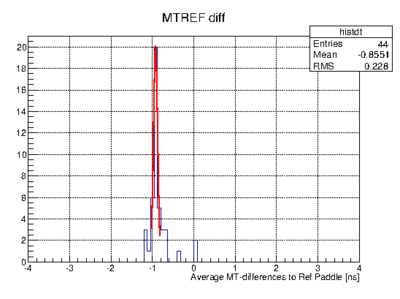 average difference of mean time to REFERENCE PADDLE
average difference of mean time to REFERENCE PADDLE - Now we have offsets for the Mean-Time for all Paddles w.r.t. THE REFERENCE PADDLE
- calculate MeanTime of Paddle i in plane j:
- Do time difference comparison of one paddle with the paddle number in the other plane
- calculate time difference:

- plot this time difference vs. paddle number of paddles that got hit in the other plane
-
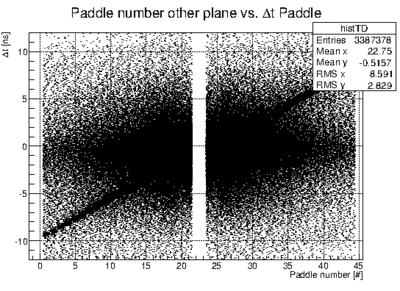
- again look at each projection and fit the
 peak
peak -
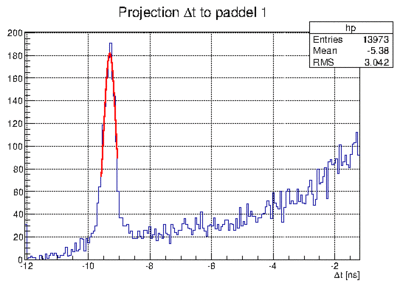
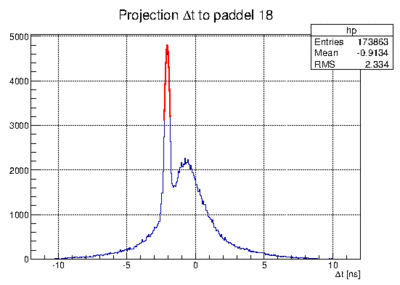 example fits
example fits - now one can also plot the fit results as a function of paddle number. The inverse slope is the speed module paddle pitch
-
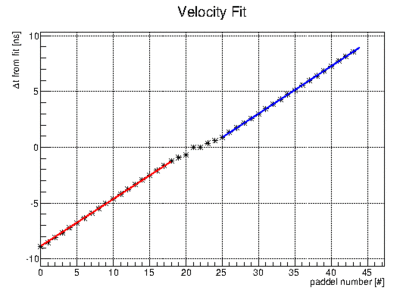
- one can also plot the difference between symmetric paddles around the beam hole

-
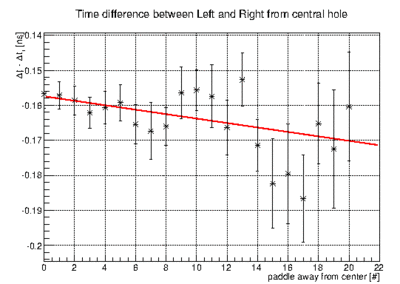 choose the intersection at zero for the time difference offset
choose the intersection at zero for the time difference offset
- calculate time difference:
- Now we have offsets for time difference (TD) and mean time (MT)
- offset for the left pmt:

- offset for the right pmt:

- as a bonus we get the effective speed of light for each paddle.
- offset for the left pmt:

